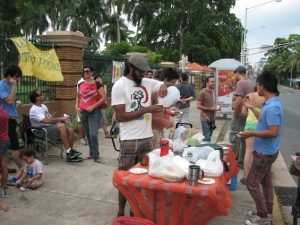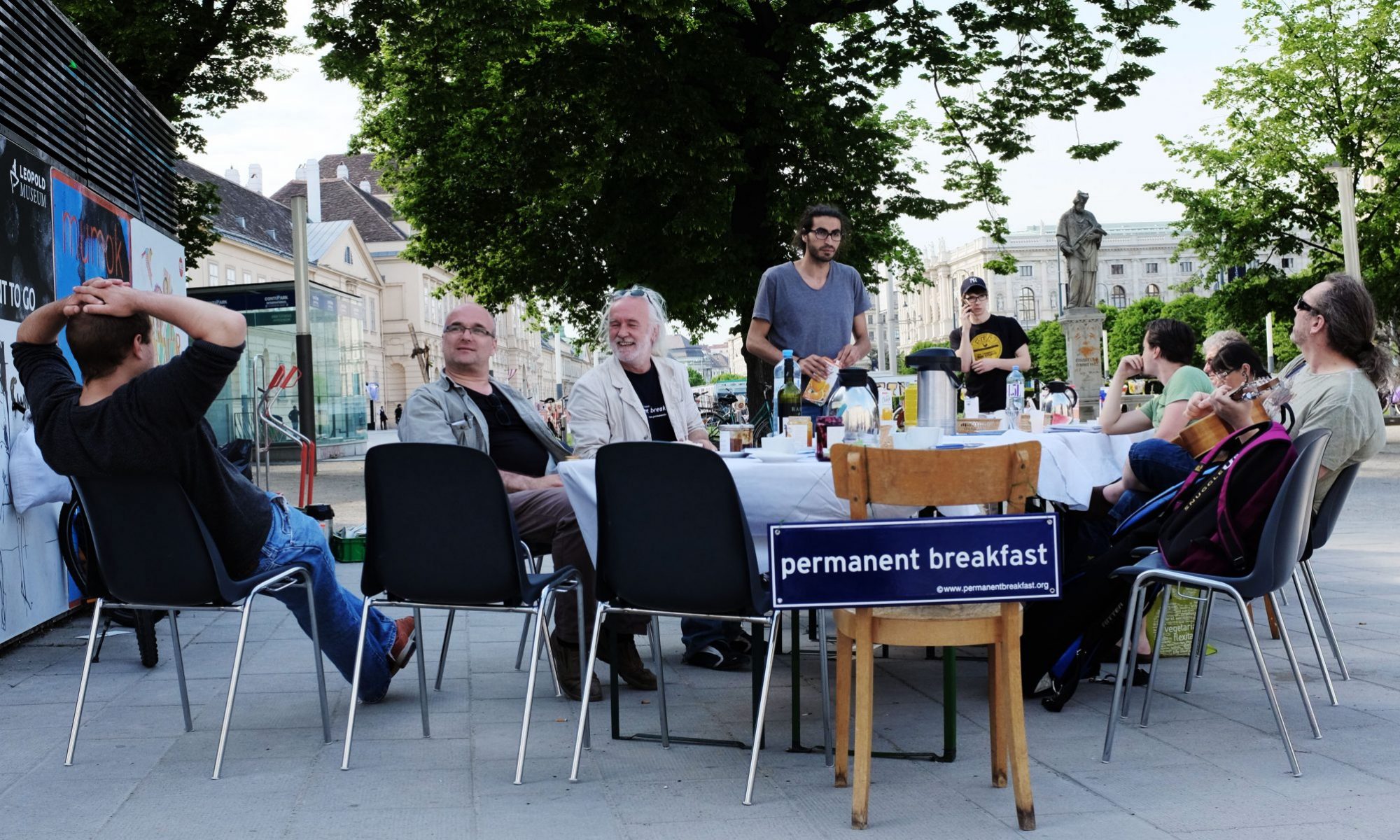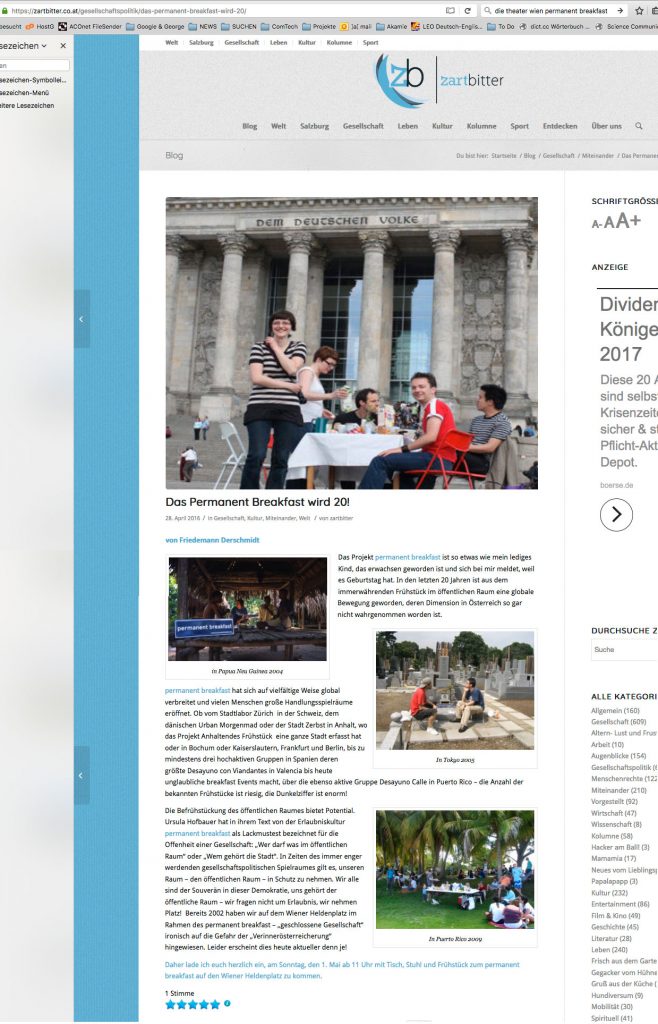
http://andreabauza.info/Desayuno-Calle

the continually ongoing breakfast in public places
https://www.permanentbreakfast.org/
On Saturday November 12th 2011, six Lebanese friends gathered in Ramlet el Baida for a permanent breakfast. Deprived from open public spaces in the country, we chose one of the surviving public beaches in the country ! In Lebanon and especially Beirut, beaches are turning into exclusive private beach clubs. With yummy labneh, zaatar, foul and balila, we celebrated open public spaces and Dima’s and Pia’s Scorpio birthdays on a sunny November morning, and enjoyed the beach with kites and Poi !
One person invites to breakfast in a public space –
the invited persons (usually 4) commit themselves to organize another public breakfast with different persons in a different place as soon as possible, and so on and so forth.
Following the snowball principle, there would be 1.6 mio. people publicly breakfasting no later than on the tenth day.
Nr.1
5 people are sitting around a set table, breakfasting in a public place. One of them has had invited.
Nr.2
Every breakfast has to be recognizably one ( clothes, set table, chairs, foot ) and is an individual happening in the public.
Nr.3
Every one of the invited ones has to organize a public breakfast as soon as possible, with different participants in a different place. The one that does the inviting covers the costs.
Nr.4
The breakfasting persons invite passer-bys to their table and tell them about the rules of the game.
Nr.5
The starting of new breakfast lines is welcome.
Nr.6
In case of unpredictable or unavoidable problems ( bad weather, thread of loss of working place….) should the breakfast take place at the next possible agreeable date.
Nr.7
For the juridical side ( depending on your countries laws about meeting in public places ) of the breakfast , every one has to take care individually. Everyone is in charge of his own breakfast.
Nr.8
For the planed “PermanentBreak – Feast” (invitations will follow eventually) and the “Breakfast Catalog” lots of material will be needed: the participants should document their breakfast (photos, videos, audio tracks, written testimonies…) and send their results to:
friedemann derschmidt
genzgasse 122/18
A-1180 Vienna
Austria
office-at-p-breakfast-dot-net
On the morning of the first of may 1996 a group of artists around friedemann derschmidt began to breakfast in public
places. The idea is quite simple and catching: one person invites to breakfast. The invited persons ( usually 4 ) commit themselves to invite to a public breakfast on the next possible date. And so on.
As a matter of fact, the public breakfast became a kind of cult, and more often people could be seen taking a seat at a beautifully
set breakfast table standing on a spare parking space in a parking lot, an empty disfunctional fountain or in parks or malls. Hundreds of photos (some of them from Praha, Berlin, Oslo and Melbourn to name a few ) have been sent as prove of the many different places and breakfasts that have had been held.
Some expected breakfast results could be observed : The public space changes to the needs of the breakfasting people.The breakfasters start to communicate with their surroundings, just by being there without much of their active doing. They become their own medium to take space, to be space and to change it – things are told, things are heard and breakfasts are eaten. Again and again and again.
EJEMPLO:
On Saturday November 12th 2011, six Lebanese friends gathered in Ramlet el Baida for a permanent breakfast. Deprived from open public spaces in the country, we chose one of the surviving public beaches in the country ! In Lebanon and especially Beirut, beaches are turning into exclusive private beach clubs. With yummy labneh, zaatar, foul and balila, we celebrated open public spaces and Dima’s and Pia’s Scorpio birthdays on a sunny November morning, and enjoyed the beach with kites and Poi !
NOTICIA SOBRE SIMILARES INICIATIVAS EN ESPAÑA:
Hello,
I am responding on the question that was indirectly asked to me by Addy Chávez, this question came from Friedmann (I supose the person who is reading this). There was a breakfast initiative in Madrid and the person who organised it is a verry nice, interesting and talentfull artist, her name is Remedios Vincent and her webpage is called: Flores en el atico. So I advice your Chzeque friend to look at her blog (which is a good liberary of what goes around in the cultural world) and to make contact with her using the references on the blog. The public breakfast (which was called desayuno en la luna/ breakfast on the moon) in madrid does not excist anymore, and I know that Remedios was sad about that, so …
I am Michael, a Flemish artist resident in Valencia. Together with 4 more (architects and artists) we made our breakfastclub,desayuno con viandantes/breakfast with passengers, in Valencia. It was a succes thats way it still excists and repeats itself every month. (from november 2008)
We where lucky to meet people who believed in the project, like Addy who made a documentary.
We have the idea to organise a maxi-breakfast in the near future, this by gathering all the breakfast initiatives that excist (speaking realisticly proberly only in Spain). I hope to keep in thoughs with permanent breakfast, which we could call our godfather.
An honor,
Michael Filez.

10.06. – 16.09.2007
INSTANT URBANISM schafft eine konzeptionelle Verbindung zur historischen Ausstellung im Museum Tinguely über die Situationistische Internationale, indem sie die radikalen Forderungen der Situationisten hinsichtlich der Umgestaltung von Architektur und Stadträumen aufgreift und thematisiert.
Die Ausstellung beginnt mit einem assoziativen Streifzug durch Aussagen und Entwürfe von Pionieren der experimentellen Architektur und Städtebau, die parallel zur situationistischen Bewegung das Metier hinterfragt und neu durchdacht haben.
Die Ausstellung führt dann entscheidende Projekte aus der zeitgenössischen Architektur und Urbanismus zusammen, welche die Ansätze der urbanen Kritik und Theorie der Situationisten heute in die Praxis umzusetzen vermögen. Durch die Dokumentation von Interventionen und Aktionen im öffentlichen Raum präsentiert INSTANT URBANISM dabei u.a. Arbeiten von Lucy Orta (London/Paris), Santiago Cirugeda (Sevilla), EXYZT (Paris), Srdjan Jovanovic Weiss (Belgrad/Basel), NL Architects (Amsterdam), IaN+ (Rom), PPAG (Wien). Temporäre und modulare Architektur stützt sich auf die flexible Nutzung des Stadtraums und setzt sich mit der prekären Natur urbaner Territorien auseinander. Im Geiste der Situationisten werden durch ‚konstruierte Situationen’ Städte als Orte des Spiels, der ‚Sportification’ und der ‚Appropriation’ umdefiniert. Neue Ansätze in der Stadtforschung sowie gebauten Architektur interpretieren die Idee der Raumerweiterung durch Selbstgestaltung und Besetzung des urbanen Raums.
Zwei Installationen werfen einen zeitgenössischen Blick auf die situationistische Strategie des ‚Dérive’ – das Umherschweifen in der Stadt – um mittels Desorientierung und Intuition die zunehmend fragmentierte Landschaft des urbanen Raums zu erkunden. Eine Reihe audio-visueller Reisen des Künstler/Architekten-Netzwerks Citámbulos (Mexico City) erzeugen eine neue Wahrnehmung von Mexico City. Der Grafikdesigner Ruedi Baur (Zürich/Paris) bewandert 6 Städte und produziert visuelle Erzählungen, in denen scheinbar banale Zeichen als Wegweiser implementiert werden.
„Für die Allgemeinheit ist die Beschaffenheit der Architektur eine feste Größe, von der man auf eigene Gefahr abweicht – was eigentlich ironisch ist, da es für die Welt insgesamt viel besser und sicherlich viel interessanter wäre, wenn es mehr Abweichungen gäbe.“ Rem Koolhaas
Die situationistische Praxis des ‚Détournement’, die Zweckentfremdung und Rekontextualisierung ästhetischer Bestandteile mit der Absicht aufzuzeigen, wie unsere Nutzung von Raum konditioniert ist, wird in der Architektur als Crossprogramming und Hybridität interpretiert. Hier kommen die Arbeiten von Diller Scofidio (New York), Bernard Tschumi (New York), NL Architects (Amsterdam), Observatorium (Rotterdam) und Atelier Bow Wow (Tokyo) ins Spiel, in denen Architektur neu programmiert wird und Räume für bisher unvorstellbare Zwecke umdefiniert werden.
